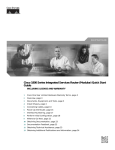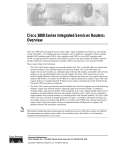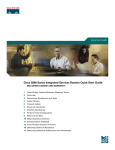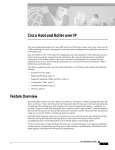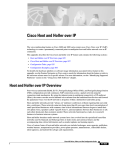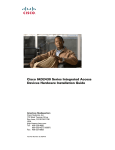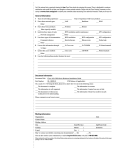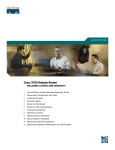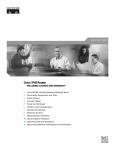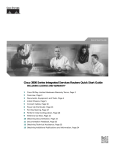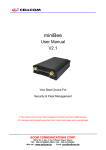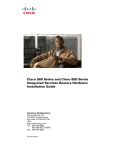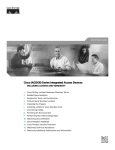Download Cisco Systems 1800 Router User Manual
Transcript
Quick Start Guide Cisco 1800 Series Integrated Services Router (Modular) Quick Start Guide INCLUDING LICENSE AND WARRANTY 1 Cisco One-Year Limited Hardware Warranty Terms, page 2 2 Overview, page 3 3 Documents, Equipment, and Tools, page 3 4 Install Chassis, page 4 5 Connecting Cables, page 13 6 Power Up the Router, page 15 7 Interface Numbering, page 17 8 Perform Initial Configuration, page 18 9 Where to Go Next, page 22 10 Obtaining Documentation, page 23 11 Documentation Feedback, page 23 12 Obtaining Technical Assistance, page 23 13 Obtaining Additional Publications and Information, page 24 1 Cisco One-Year Limited Hardware Warranty Terms There are special terms applicable to your hardware warranty and various services that you can use during the warranty period. Your formal Warranty Statement, including the warranties and license agreements applicable to Cisco software, is available on Cisco.com. Follow these steps to access and download the Cisco Information Packet and your warranty and license agreements from Cisco.com. 1. Launch your browser, and go to this URL: http://www.cisco.com/univercd/cc/td/doc/es_inpck/cetrans.htm The Warranties and License Agreements page appears. 2. To read the Cisco Information Packet, follow these steps: a. Click the Information Packet Number field, and make sure that the part number 78-5235-03A0 is highlighted. b. Select the language in which you would like to read the document. c. Click Go. The Cisco Limited Warranty and Software License page from the Information Packet appears. d. Read the document online, or click the PDF icon to download and print the document in Adobe Portable Document Format (PDF). Note You must have Adobe Acrobat Reader to view and print PDF files. You can download the reader from Adobe’s website: http://www.adobe.com 3. To read translated and localized warranty information about your product, follow these steps: a. Enter this part number in the Warranty Document Number field: 78-10747-01C0. b. Select the language in which you would like to view the document. c. Click Go. The Cisco warranty page appears. d. Review the document online, or click the PDF icon to download and print the document in Adobe Portable Document Format (PDF). You can also contact the Cisco service and support website for assistance: http://www.cisco.com/en/US/support/ Duration of Hardware Warranty One (1) Year Replacement, Repair, or Refund Policy for Hardware Cisco or its service center will use commercially reasonable efforts to ship a replacement part within ten (10) working days after receipt of a Return Materials Authorization (RMA) request. Actual delivery times can vary, depending on the customer location. Cisco reserves the right to refund the purchase price as its exclusive warranty remedy. To Receive a Return Materials Authorization (RMA) Number Contact the company from whom you purchased the product. If you purchased the product directly from Cisco, contact your Cisco Sales and Service Representative. Complete the information below, and keep it for reference. Company product purchased from Company telephone number Product model number Product serial number Maintenance contract number 2 2 Overview The Cisco 1800 series integrated services routers includes the Cisco 1841 router, which is a data-only router. Cisco 1841 routers support WAN interface cards (WIC), voice/WAN interface cards (VWICs) in data mode only, single-wide high-speed WAN interface cards (HWICs), and advanced integration module (AIMs). This router has two WIC/VWIC/HWIC slots. Note The interface numbering for this Cisco 1841 router is different from the numbering in Cisco 1700 series routers. (See the “Interface Numbering” section on page 16.) This document provides the minimum necessary information to help you install the router, power it up, and configure a network connection. This document directs you to other documents for the following information: • More detailed router installation instructions, descriptions, and specifications • Procedures for installing modules, interface cards, power supplies, and memory • Software configuration • Regulatory compliance and safety information Product Serial Number Location The serial number label for the Cisco 1841 router is located on the rear of the chassis, underneath interface card slot 0. For detailed product serial number location on the chassis, refer to the online Cisco 1800 series hardware installation documentation at the following URL: http://www.cisco.com/univercd/cc/td/doc/product/access/acs_mod/1800/hw/index.htm Cisco Product Identification Tool The Cisco Product Identification (CPI) tool provides detailed illustrations and descriptions showing where to locate serial number labels on Cisco products. It includes the following features: • A search option that allows browsing for models using a tree-structured product hierarchy • A search field on the final results page making it easier to look up multiple products • End of sale products are clearly identified in results lists The tool streamlines the process of locating serial number labels and identifying products. Serial number information expedites the entitlement process and is important for access to support services. The Cisco Product Identification tool can be accessed at the following URL: http://tools.cisco.com/Support/CPI/index.do 3 Documents, Equipment, and Tools User Documentation For complete platform documentation, refer to the following URL: http://www.cisco.com/univercd/cc/td/doc/product/access/acs_mod/1800/index.htm All the documents referenced in this quick start guide are available on Cisco.com. See the “Where to Go Next” section on page 21. To view or print an online document in its original page format, click the PDF icon. Translated Versions http://www.cisco.com/univercd/cc/td/doc/product/access/acs_mod/1800/qsg/index.htm 3 http://www.cisco.com/univercd/cc/td/doc/product/access/acs_mod/1800/qsg/index.htm Items Included with Cisco 1841 Routers Your router package should include the following items in addition to the router: • One blue RJ-45-to-DB-9 console cable; one DB-9-to-DB-25 modem adapter • Power cord • Cisco.com card; Cisco product registration card • Regulatory Compliance and Safety Information for Cisco 1840 Routers document • Cisco Router and Security Device Manager (SDM) Quick Start Guide document • Cisco 1800 Series Integrated Services Routers (Modular) Quick Start Guide (this document) Items Not Included Individual items in this list may be required for your installation: • PC with Hyperterminal or similar terminal emulation program, or a modem for remote administrative access • Cables for WAN interfaces, LAN interfaces, or USB interface • Cable ties, number 2 Phillips screwdriver • Other typical equipment, such as channel service unit/data service unit (CSU/DSU); NT1 device for ISDN-BRI S/T; Ethernet hub; USB devices Note The onboard USB ports (version 1.1) support only USB devices approved and qualified by Cisco. Note The USB port (version 1.1) is intended for future use only. 4 Install Chassis This section contains basic installation procedures. For more detailed installation instructions, refer to the Cisco 1800 series hardware installation documentation at the following URL: http://www.cisco.com/univercd/cc/td/doc/product/access/acs_mod/1800/hw/index.htm Safety Information The Regulatory Compliance and Safety Information for Cisco 1840 Routers document contains translations of the warnings that appear in this quick start guide. For safety information you must know before working on your Cisco router, refer to the Regulatory Compliance and Safety Information for Cisco 1840 Routers document that accompanied this device. 4 Warning Definition Warning IMPORTANT SAFETY INSTRUCTIONS This warning symbol means danger. You are in a situation that could cause bodily injury. Before you work on any equipment, be aware of the hazards involved with electrical circuitry and be familiar with standard practices for preventing accidents. Use the statement number provided at the end of each warning to locate its translation in the translated safety warnings that accompanied this device. Statement 1071 SAVE THESE INSTRUCTIONS Waarschuwing BELANGRIJKE VEILIGHEIDSINSTRUCTIES Dit waarschuwingssymbool betekent gevaar. U verkeert in een situatie die lichamelijk letsel kan veroorzaken. Voordat u aan enige apparatuur gaat werken, dient u zich bewust te zijn van de bij elektrische schakelingen betrokken risico's en dient u op de hoogte te zijn van de standaard praktijken om ongelukken te voorkomen. Voor een vertaling van de waarschuwingen die in deze publicatie verschijnen, dient u de vertaalde veiligheidswaarschuwingen te raadplegen die bij dit apparaat worden geleverd. Opmerking BEWAAR DEZE INSTRUCTIES. Varoitus TÄRKEITÄ TURVALLISUUTEEN LIITTYVIÄ OHJEITA Tämä varoitusmerkki merkitsee vaaraa. Olet tilanteessa, joka voi johtaa ruumiinvammaan. Ennen kuin työskentelet minkään laitteiston parissa, ota selvää sähkökytkentöihin liittyvistä vaaroista ja tavanomaisista onnettomuuksien ehkäisykeinoista. Tässä asiakirjassa esitettyjen varoitusten käännökset löydät laitteen mukana toimitetuista ohjeista. Huomautus SÄILYTÄ NÄMÄ OHJEET Attention IMPORTANTES INFORMATIONS DE SÉCURITÉ Ce symbole d'avertissement indique un danger. Vous vous trouvez dans une situation pouvant causer des blessures ou des dommages corporels. Avant de travailler sur un équipement, soyez conscient des dangers posés par les circuits électriques et familiarisez-vous avec les procédures couramment utilisées pour éviter les accidents. Pour prendre connaissance des traductions d'avertissements figurant dans cette publication, consultez les consignes de sécurité traduites qui accompagnent cet appareil. Remarque CONSERVEZ CES INFORMATIONS Warnung WICHTIGE SICHERHEITSANWEISUNGEN Dieses Warnsymbol bedeutet Gefahr. Sie befinden sich in einer Situation, die zu einer Körperverletzung führen könnte. Bevor Sie mit der Arbeit an irgendeinem Gerät beginnen, seien Sie sich der mit elektrischen Stromkreisen verbundenen Gefahren und der Standardpraktiken zur Vermeidung von Unfällen bewusst. Übersetzungen der in dieser Veröffentlichung enthaltenen Warnhinweise sind im Lieferumfang des Geräts enthalten. Hinweis BEWAHREN SIE DIESE SICHERHEITSANWEISUNGEN AUF 5 Avvertenza IMPORTANTI ISTRUZIONI SULLA SICUREZZA Questo simbolo di avvertenza indica un pericolo. La situazione potrebbe causare infortuni alle persone. Prima di intervenire su qualsiasi apparecchiatura, occorre essere al corrente dei pericoli relativi ai circuiti elettrici e conoscere le procedure standard per la prevenzione di incidenti. Per le traduzioni delle avvertenze riportate in questo documento, vedere le avvertenze di sicurezza che accompagnano questo dispositivo. Nota CONSERVARE QUESTE ISTRUZIONI Advarsel VIKTIGE SIKKERHETSINSTRUKSJONER Dette varselssymbolet betyr fare. Du befinner deg i en situasjon som kan forårsake personskade. Før du utfører arbeid med utstyret, bør du være oppmerksom på farene som er forbundet med elektriske kretssystemer, og du bør være kjent med vanlig praksis for å unngå ulykker. For å se oversettelser av advarslene i denne publikasjonen, se de oversatte sikkerhetsvarslene som følger med denne enheten. Merk TA VARE PÅ DISSE INSTRUKSJONENE Aviso INSTRUÇÕES IMPORTANTES DE SEGURANÇA Este símbolo de aviso significa perigo. O utilizador encontra-se numa situação que poderá ser causadora de lesões corporais. Antes de iniciar a utilização de qualquer equipamento, tenha em atenção os perigos envolvidos no manuseamento de circuitos eléctricos e familiarize-se com as práticas habituais de prevenção de acidentes. Para ver traduções dos avisos incluídos nesta publicação, consulte os avisos de segurança traduzidos que acompanham este dispositivo. Nota GUARDE ESTAS INSTRUÇÕES ¡Advertencia! INSTRUCCIONES IMPORTANTES DE SEGURIDAD Este símbolo de aviso indica peligro. Existe riesgo para su integridad física. Antes de manipular cualquier equipo, considere los riesgos de la corriente eléctrica y familiarícese con los procedimientos estándar de prevención de accidentes. Vea las traducciones de las advertencias que acompañan a este dispositivo. Nota GUARDE ESTAS INSTRUCCIONES Varning! VIKTIGA SÄKERHETSANVISNINGAR Denna varningssignal signalerar fara. Du befinner dig i en situation som kan leda till personskada. Innan du utför arbete på någon utrustning måste du vara medveten om farorna med elkretsar och känna till vanliga förfaranden för att förebygga olyckor. Se översättningarna av de varningsmeddelanden som finns i denna publikation, och se de översatta säkerhetsvarningarna som medföljer denna anordning. OBS! SPARA DESSA ANVISNINGAR 6 Aviso INSTRUÇÕES IMPORTANTES DE SEGURANÇA Este símbolo de aviso significa perigo. Você se encontra em uma situação em que há risco de lesões corporais. Antes de trabalhar com qualquer equipamento, esteja ciente dos riscos que envolvem os circuitos elétricos e familiarize-se com as práticas padrão de prevenção de acidentes. Use o número da declaração fornecido ao final de cada aviso para localizar sua tradução nos avisos de segurança traduzidos que acompanham o dispositivo. GUARDE ESTAS INSTRUÇÕES 7 Advarsel VIGTIGE SIKKERHEDSANVISNINGER Dette advarselssymbol betyder fare. Du befinder dig i en situation med risiko for legemesbeskadigelse. Før du begynder arbejde på udstyr, skal du være opmærksom på de involverede risici, der er ved elektriske kredsløb, og du skal sætte dig ind i standardprocedurer til undgåelse af ulykker. Brug erklæringsnummeret efter hver advarsel for at finde oversættelsen i de oversatte advarsler, der fulgte med denne enhed. GEM DISSE ANVISNINGER 8 Warning Before working on a system that has an on/off switch, turn OFF the power and unplug the power cord. Statement 1 Warning Read the installation instructions before connecting the system to the power source. Statement 1004 Warning Take care when connecting units to the supply circuit so that wiring is not overloaded. Statement 1018 Warning Only trained and qualified personnel should be allowed to install, replace, or service this equipment. Statement 1030 Warning Ultimate disposal of this product should be handled according to all national laws and regulations. Statement 1040 9 Warning To prevent the system from overheating, do not operate it in an area that exceeds the maximum recommended ambient temperature of 40 deg. Statement 1047 Warning There is the danger of explosion if the battery is replaced incorrectly. Replace the battery only with the same or equivalent type recommended by the manufacturer. Dispose of used batteries according to the manufacturer’s instructions. Statement 1015 Installing the Router Note Cisco 1800 series routers are normally ordered with modules and interface cards. Before you remove or install any modules or interface cards, refer to the documents that accompany those items or to the online Cisco 1800 series hardware installation documentation at the following URL: http://www.cisco.com/univercd/cc/td/doc/product/access/acs_mod/1800/hw/index.htm You can set any Cisco 1800 series router on a desktop. See the applicable instructions in the following section: • Installing the Router on a Desktop, page 10 Caution To prevent damage to the chassis, never attempt to lift or tilt the chassis by the plastic panel on the front. Always hold the chassis by the metal body. Installing the Router on a Desktop The Cisco 1841 router is shipped with the rubber feet attached to the chassis. Caution Your chassis installation must allow unrestricted airflow for chassis cooling. For placing on a desktop, keep at least one inch of clear space beside the cooling inlet and exhaust vents. Caution Do not place any items that weigh more than 10 pounds (4.5 kilograms) on top of the chassis, and do not stack routers on top of each other. Grounding the Chassis Warning This equipment must be grounded. Never defeat the ground conductor or operate the equipment in the absence of a suitably installed ground conductor. Contact the appropriate electrical inspection authority or an electrician if you are uncertain that suitable grounding is available. Statement 1024 Warning During this procedure, wear grounding wrist straps to avoid ESD damage to the card. Do not directly touch the backplane with your hand or any metal tool, or you could shock yourself. Statement 94 10 Warning This equipment needs to be grounded. Use a green and yellow 14 AWG ground wire to connect the host to earth ground during normal use. Statement 190 To connect the chassis to a reliable earth ground, using a ring terminal and size 14 AWG (2 mm 2) wire, follow these steps: 11 Step 1 Strip one end of the ground wire to expose approximately 3/4 inch (20 mm) of conductor. Step 2 Crimp the 14 AWG green ground wire to a UL Listed/CSA certified ring terminal, using a crimping tool that is recommended by the ring terminal manufacturer. The ring terminal provided on the back panel of the router is suitable for a No. 6 grounding screw. Step 3 Attach the ring terminal to the chassis as shown in Figure 1. Use a number 2 Phillips screwdriver and the screw supplied with the ring terminal. Tighten the screw to a torque of 8 to 10 inch-pounds (0.9 to 1.1 newton meters.) Step 4 Connect the other end of the ground wire to a known good electrical grounding point such as a service panel grounding lug. Consult a licensed electrician if you have any questions about the suitability of the ground connection. Chassis Ground Connection on the Cisco 1841 Router CISCO 1841 100-240 VAC1A 50/60 Hz 117083 Figure 1 Ring terminal attachment 5 Connecting Cables Warning Do not work on the system or connect or disconnect cables during periods of lightning activity. Statement 1001 This section provides an overview of the cabling for different ports and connections on the Cisco 1841 router. For detailed information on the connections, cables, and pinouts, refer to the following documents: • Cisco Interface Cards Installation Guide at the following URL: http://www.cisco.com/univercd/cc/td/doc/product/access/acs_mod/cis2600/hw_inst/wic_inst/wic_doc/index.htm • Cisco Modular Access Router Cable Specifications at the following URL: http://www.cisco.com/univercd/cc/td/doc/product/access/acs_mod/cis3600/hw_inst/cabling/marcabl.htm WAN and LAN Connections The connections and cables listed in Table 1 are described in detail in the Cisco 1800 series hardware installation documents at the following URL: http://www.cisco.com/univercd/cc/td/doc/product/access/acs_mod/1800/hw/index.htm Caution Do not connect a WAN, telephone, or fax cable to an interface card until you have completed the installation procedure. Warning Hazardous network voltages are present in WAN ports regardless of whether power to the router is OFF or ON. To avoid electric shock, use caution when working near WAN ports. When detaching cables, detach the end away from the router first. Statement 1026 12 Table 1 summarizes the basic WAN and LAN connections for the Cisco 1841 router. Table 1 WAN and LAN Connections Port or Connection Port Type, Color1 Connected To: Cable Fast Ethernet (FE) RJ-45, yellow Ethernet hub Crossover to connect to a router Straight-through to connect to a switch T1/E1 WAN RJ-48C T1 or E1 network or CSU/DSU RJ-48 T1/E1 straight-through (Crossover to connect ot a PBX or any other equipment) Cisco serial (1T) 60-pin D-sub, blue CSU/DSU and serial network or equipment Cisco Smart serial (2T) Cisco Smart compact connector, blue CSU/DSU and serial network or equipment Cisco serial transition cable that matches the signaling protocol (EIA/TIA-232, EIA/TIA-449, V.35, X.21, or EIA/TIA-530) and the serial port operating mode (DTE or DCE). For WIC-2T and WIC-2A/S only DSL RJ-11C/RJ-14C Network demarcation device for service provider’s DSL interface PINX3 Refer to the Cisco Modular Access Router Cable Specifications document for information about selecting these cables. RJ-11 straight-through for 2-wire RJ-14 straight-through for 4-wire BRI S/T WAN (external NT12) RJ-45, orange NT1 device or BRI U WAN (built-in NT1) RJ-49C/CA-A11, orange ISDN network RJ-49 straight-through Analog modem RJ-11 PSTN RJ-11 straight-through 56/64-kbps CSU/DSU 8-pin modular RJ-48S interface RJ-48 straight-through RJ-45 straight-through 1. The color codes are specific to cables shipped by Cisco 2. NT1 = Network Termination 1 3. PINX = Private integrated network exchange Console, Auxiliary, and USB Port Connections The connections described in Table 2 provide system management access. Note The USB port (version 1.1) is intended for future use only. Table 2 Console and Auxiliary Port Connections Port or Connection Color or Type Connected To: Cable Console Light blue PC or ASCII terminal communication port (usually labeled COM) RJ-45-to-DB-9 console cable Auxiliary Black Modem for remote access RJ-45-to-DB-9 console cable and DB-9-to-DB-25 adapter USB — Peripheral devices USB cable 13 Power Connections Connect the router power cord to a 15A, 120 VAC power source or 10A, 240 VAC power source. Warning Note This product relies on the building’s installation for short-circuit (overcurrent) protection. Ensure that the protective device is rated not greater than: 15A, 120VAC (10A, 240VAC). Statement 1005 The input voltage tolerance limits for AC power are 85 and 264 VAC. 6 Power Up the Router Checklist for Power Up You are ready to power up the Cisco 1841 router after the following steps are completed: • Chassis is securely mounted and grounded. (See the “Install Chassis” section on page 4.) • Power and interface cables are connected. (See the “Connecting Cables” section on page 12.) • Make sure that the external CompactFlash memory card is properly seated into the slot. For installation instructions, refer to the online Cisco 1800 series hardware installation documentation at the following URL: http://www.cisco.com/univercd/cc/td/doc/product/access/acs_mod/1800/hw/index.htm • PC with terminal emulation program is connected to the console port, powered up, and configured for 9600 baud, 8 data bits, 1 stop bit, no flow control, and no parity. • Suitable PC COM port is selected in the terminal emulation program. Note For initial power up, a direct console connection is recommended. After the initial configuration is completed, a remote modem connection can be used for router management. Caution To ensure adequate cooling, never operate the router unless the cover and all modules and cover plates are installed. Caution To prevent damage to the ejector mechanism, the ejector button next to the CompactFlash memory card must remain fully seated when not being used to eject a CompactFlash memory card. Power-Up Procedure To power up your Cisco 1841 router and verify that it goes through its initialization and self-test, perform this procedure. When the procedure is finished, the Cisco 1841 router is ready to configure. Note To view the boot sequence, you must have a console connection to the Cisco 1841 router before it powers up. Step 1 Make sure that your PC is powered up and connected as described in the “Checklist for Power Up” section on page 14. Step 2 Move the power switch to the ON position. The SYS PWR LED on the front of the chassis blinks green and the fans operate. If this does not happen, refer to the "Troubleshooting" module in the online Cisco 1800 series hardware installation documentation at the following URL: 14 http://www.cisco.com/univercd/cc/td/doc/product/access/acs_mod/1800/hw/index.htm Startup messages appear in your terminal emulation program window. When the startup messages end, the SYS PWR LED comes on solid green. Do not press any keys on the keyboard until the messages stop and the SYS PWR LED is solid green. Any keys pressed during this time are interpreted as the first command typed when the messages stop, which might cause the router to power off and start over. It takes a few minutes for the messages to stop. Caution You may see different startup messages: • If you see the following messages, the router has booted with a configuration file and is ready for initial configuration using Cisco Router and Security Device Manager (SDM): yourname con0 is now available Press RETURN to get started. Note Because SDM is installed on your router by default, we recommend using SDM to perform the initial configuration. If SDM is installed on your router, we recommend using SDM to perform the initial configuration. See the “Initial Configuration Using Cisco Router and Security Device Manager” section on page 17 to learn how to configure your router using SDM, or how to obtain SDM and install it on your router. • If you see the following messages, the router has booted and is ready for initial configuration using the setup command facility or the command-line interface (CLI): --- System Configuration Dialog --At any point you may enter a question mark '?' for help. Use ctrl-c to abort configuration dialog at any prompt. Default settings are in square brackets '[]'. Would you like to enter the initial configuration dialog? [yes/no]: To learn how to use the setup command facility to configure the router, see the “Initial Configuration Using Setup Command Facility” section on page 17. To learn how to use the CLI to configure the router, see the “Initial Configuration Using Cisco CLI—Manual Configuration” section on page 20. If the rommon 1> prompt appears, your system has booted in ROM monitor mode. For information on using ROM monitor, refer to the “Troubleshooting and Maintenance” module in the online Cisco 1800 series software configuration documentation at the following URL: http://www.cisco.com/univercd/cc/td/doc/product/access/acs_mod/1800/sw/index.htm Verify the Front Panel LED Indications The indicator LEDs described in Table 3 provide power, activity, and status information. Table 3 LED Indicators LED Color Description Location SYS PWR Green Router has successfully booted up and the software is functional. This LED blinks while booting or in the ROM monitor. SYS ACT Green Blinking when any packets are transmitted or received on any WAN or LAN, or when Front monitoring system activity. Front 15 Table 3 LED Indicators (continued) LED Color CF Green Description Location On when compact flash memory is busy. Do not remove CompactFlash memory card Back when this light is on. FDX (FE 0) Green On indicates full-duplex operation. Off indicates half-duplex operation. Back 100 (FE 0) On indicates a 100-Mbps link. Off indicates a 10-Mbps link. Back Link (FE 0) Green On when the router is correctly connected to a local Ethernet LAN through Ethernet port 0. Back FDX (FE 1) Green On indicates full-duplex operation. Off indicates half-duplex operation. Back 100 (FE 1) On indicates a 100-Mbps link. Off indicates a 10-Mbps link. Back Link (FE 1) Green On when the router is correctly connected to a local Ethernet LAN through Ethernet port 1. Back AIM On indicates presence of an AIM in the internal AIM slot. Back Green Green Green Verify the Hardware Configuration Verify the router hardware configuration by entering the following commands: • show version—Displays the system hardware version; the installed software version; the names and sources of configuration files; the boot images; and the amount of installed DRAM, NVRAM, and flash memory. • show diag—Lists and displays diagnostic information about the installed controllers, interface processors, and port adapters. Typical examples are network modules, interface cards (WICs, VWICs, HWICs) and advanced integration modules (AIMs). 7 Interface Numbering Each individual interface (port) on a Cisco 1841 router is identified by a number. A Cisco 1841 router contains the following wide-area network (WAN) and local-area network (LAN) interface types: • Two onboard Fast Ethernet LAN interfaces • Two slots in which you can install WICs, VWICs (data only), and HWICs The numbering format for the slots is interface-type 0/slot-number/port-number. Table 4 summarizes the interface numbering. Table 4 Interface Numbering Slot Number Slot Type Onboard Ports Fast Ethernet 2 Slot 0 HWIC/WIC/VWIC Slot 1 HWIC/WIC/VWIC2 Slot Numbering Range Example1 0/0 and 0/1 interface fastethernet 0/0 0/0/0 to 0/0/3 interface serial 0/0/0 line async 0/0/0 0/1/0 to 0/1/3 interface serial 0/1/0 line async 0/1/0 1. The interfaces listed are examples only; other possible interface types are not listed. 2. VWICs are data-only in Cisco 1841 routers. 16 Note On the Cisco 1841 router, the numbering format for configuring an async interface is 0/slot/port. To configure the line associated with an async interface, simply use the interface number to specify the async line. For example, line 0/0/0 specifies the line associated with interface serial 0/0/0 on a WIC-2A/S in slot 0. Similarly, line 0/1/1 specifies the line associated with interface async 0/1/1 on a WIC-2AM in slot 1. 8 Perform Initial Configuration You can configure your router by using one of the following tools: • Cisco Router and Security Device Manager (SDM)—See the “Initial Configuration Using Cisco Router and Security Device Manager” section on page 17. • Setup command facility—See the “Initial Configuration Using Setup Command Facility” section on page 17. • Command-line interface (CLI)—See the “Initial Configuration Using Cisco CLI—Manual Configuration” section on page 20. Initial Configuration Using Cisco Router and Security Device Manager If the following messages appear at the end of the startup sequence, Cisco Router and Security Device Manager (SDM) is installed on your router: yourname con0 is now available Press RETURN to get started. For instructions on configuring your router by using SDM, refer to the Cisco Router and Security Device Manager (SDM) Quick Start Guide that shipped with your router. Tip If the messages above do not appear, SDM and the Cisco Router and Security Device Manager (SDM) Quick Start Guide were not shipped with your router. If you want to use SDM, you can download the latest version of SDM and instructions for installing it on your router from the following location: http://www.cisco.com/pcgi-bin/tablebuild.pl/sdm To obtain the SDM quick start guide, SDM release notes, and other SDM documentation, go to www.cisco.com/go/sdm and click the Technical Documentation link. Initial Configuration Using Setup Command Facility This section shows how to use the setup command facility to configure a hostname for the router, set passwords, and configure an interface for communication with the management network. If the following messages appear at the end of the startup sequence, the setup command facility has been invoked automatically: --- System Configuration Dialog --At any point you may enter a question mark '?' for help. Use ctrl-c to abort configuration dialog at any prompt. Default settings are in square brackets '[]'. Would you like to enter the initial configuration dialog? [yes/no]: The setup command facility prompts you for basic information about your router and network, and it creates an initial configuration file. After the configuration file is created, you can use the CLI or Cisco Router and Security Device Manager to perform additional configuration. 17 The prompts in the setup command facility vary, depending on your router model, the installed interface modules, and the software image. The following example and the user entries (in bold) are shown as examples only. For help with interface and port numbering, see the “Interface Numbering” section on page 16. Note Step 1 If you make a mistake while using the setup command facility, you can exit and run the setup command facility again. Press Ctrl-C, and enter the setup command at the privileged EXEC mode prompt (Router#). To proceed using the setup command facility, enter yes: Would you like to enter the initial configuration dialog? [yes/no]: yes Step 2 When the following messages appear, enter yes to enter basic management setup: At any point you may enter a question mark '?' for help. Use ctrl-c to abort configuration dialog at any prompt. Default settings are in square brackets '[]'. Basic management setup configures only enough connectivity for management of the system, extended setup will ask you to configure each interface on the system Would you like to enter basic management setup? [yes/no]: yes Step 3 Enter a hostname for the router (this example uses Router): Configuring global parameters: Enter host name [Router]: Router Step 4 Enter an enable secret password. This password is encrypted (more secure) and cannot be seen when viewing the configuration: The enable secret is a password used to protect access to privileged EXEC and configuration modes. This password, after entered, becomes encrypted in the configuration. Enter enable secret: xxxxxx Step 5 Enter an enable password that is different from the enable secret password. This password is not encrypted (less secure) and can be seen when viewing the configuration: The enable password is used when you do not specify an enable secret password, with some older software versions, and some boot images. Enter enable password: xxxxxx Step 6 Enter the virtual terminal password, which prevents unauthenticated access to the router through ports other than the console port: The virtual terminal password is used to protect access to the router over a network interface. Enter virtual terminal password: xxxxxx Step 7 Respond to the following prompts as appropriate for your network: Configure SNMP Network Management? [yes]: Community string [public]: A summary of the available interfaces is displayed. 18 Note The interface numbering that appears depends on the type of Cisco modular router platform and on the installed interface modules and cards. Current interface summary Controller T1 0/0/0 T1 0/0/1 T1 0/1/0 T1 0/1/1 Timeslots 24 24 24 24 D-Channel 23 23 23 23 Configurable modes pri/channelized pri/channelized pri/channelized pri/channelized Status Administratively Administratively Administratively Administratively up up up up Any interface listed with OK? value "NO" does not have a valid configuration Interface FastEthernet0/0 FastEthernet0/1 Step 8 IP-Address unassigned unassigned OK? Method Status NO unset up NO unset up Prol up dow Select one of the available interfaces for connecting the router to the management network: Enter interface name used to connect to the management network from the above interface summary: fastethernet0/0 Step 9 Respond to the following prompts as appropriate for your network: Configuring interface FastEthernet0/0: Use the 100 Base-TX (RJ-45) connector? [yes]: yes Operate in full-duplex mode? [no]: no Configure IP on this interface? [yes]: yes IP address for this interface: 172.1.2.3 Subnet mask for this interface [255.255.0.0] : 255.255.0.0 Class B network is 172.1.0.0, 26 subnet bits; mask is /16 Step 10 The configuration is displayed: The following configuration command script was created: hostname Router enable secret 5 $1$D5P6$PYx41/lQIASK.HcSbfO5q1 enable password xxxxxx line vty 0 4 password xxxxxx snmp-server community public ! no ip routing ! interface FastEthernet0/0 speed 100 half-duplex ip address 172.1.2.3 255.255.0.0 ! interface FastEthernet0/1 shutdown no ip address end Step 11 Respond to the following prompts. Select [2] to save the initial configuration. [0] Go to the IOS command prompt without saving this config. [1] Return back to the setup without saving this config. [2] Save this configuration to nvram and exit. Enter your selection [2]: 2 Building configuration... Use the enabled mode 'configure' command to modify this configuration. Press RETURN to get started! RETURN 19 The user prompt is displayed. Router> Step 12 Verify the initial configuration. See the “Verify the Initial Configuration” section on page 21 for verification procedures. Initial Configuration Using Cisco CLI—Manual Configuration This section shows how to display a command-line interface (CLI) prompt for configuration using the CLI, and it directs you to documentation for the CLI configuration. You can use the CLI if the following messages appear at the end of the startup sequence: --- System Configuration Dialog --At any point you may enter a question mark '?' for help. Use ctrl-c to abort configuration dialog at any prompt. Default settings are in square brackets '[]'. Would you like to enter the initial configuration dialog? [yes/no]: If these messages do not appear, SDM and a default configuration file were installed on the router at the factory. To use SDM to configure the router, see the “Initial Configuration Using Cisco Router and Security Device Manager” section on page 17. For help with interface and port numbering, see the “Interface Numbering” section on page 16. Step 1 To proceed with manual configuration using the CLI, enter no when the power-up messages end: Would you like to enter the initial configuration dialog? [yes/no]: no Step 2 Press Return to terminate autoinstall and continue with manual configuration: Would you like to terminate autoinstall? [yes] Return Several messages appear, ending with a line similar to the following: Copyright (c) 1986-2004 by Cisco Systems, Inc. Compiled <date> <time> by <person> Step 3 Press Return to display the Router> prompt: ... flashfs[4]: Initialization complete. Router> Step 4 Enter privileged EXEC mode: Router> enable Router# Step 5 For configuration procedures, refer to the applicable configuration instructions in the Cisco 2800 series software configuration documents. See the “Where to Go Next” section on page 21 for information about accessing these documents. Note Step 6 20 To avoid losing work you have completed, be sure to save your configuration occasionally as you proceed. Use the copy running-config startup-config command to save the configuration to NVRAM. When you have finished the initial configuration, verify the initial configuration. See the “Verify the Initial Configuration” section on page 21 for verification procedures. Verify the Initial Configuration To verify that the new interfaces are operating correctly, perform the following tests: • To verify that the interfaces are operating correctly and that the interfaces and line protocol are in the correct state—up or down—enter the show interfaces command. • To display a summary status of the interfaces configured for IP, enter the show ip interface brief command. • To verify that you configured the correct host name and password, enter the show configuration command. When you complete and verify the initial configuration, your Cisco router is ready to configure for specific functions. See the “Where to Go Next” section on page 21 for information about locating documentation for advanced configuration procedures. 9 Where to Go Next For additional configuration procedures, refer to the appropriate Cisco 1800 series routers documentation or Cisco IOS software documentation, available online on Cisco.com. Tip See the “Obtaining Documentation” section on page 21 for help in locating these documents. To access documentation on Cisco.com For Cisco 1841 router platform documentation, begin at Cisco.com at http://www.cisco.com, and select Products & Solutions > Routers > 1800 Series Integrated Services Routers> Technical Documentation > Document type > Document. For Cisco IOS software documentation, start on Cisco.com at http://www.cisco.com, and select Products & Solutions > IOS Software > Cisco IOS Software Releases > Your Cisco IOS software release. To get updated information about platform support for features, access Feature Navigator II at http://www.cisco.com/go/fn. (Requires a registered account on Cisco.com.) To access documentation using Cisco Connection Online (CCO): For Cisco 1800 series routers platform documentation, start on Cisco.com at http://www.cisco.com, and click the Technical Documentation tab under Quick Links. Under the Product Documentation heading, navigate to Modular Access Routers and to the documentation for your router. For Cisco IOS software documentation, start on Cisco.com at http://www.cisco.com, and click the Technical Documentation tab under Quick Links. Under the Product Documentation heading, navigate to the Cisco IOS software documentation for the Cisco IOS software release that is installed on your router. 10 Obtaining Documentation Cisco documentation and additional literature are available on Cisco.com. Cisco also provides several ways to obtain technical assistance and other technical resources. These sections explain how to obtain technical information from Cisco Systems. Cisco.com You can access the most current Cisco documentation at this URL: http://www.cisco.com/univercd/home/home.htm You can access the Cisco website at this URL: http://www.cisco.com You can access international Cisco websites at this URL: http://www.cisco.com/public/countries_languages.shtml 21 Ordering Documentation You can find instructions for ordering documentation at this URL: http://www.cisco.com/univercd/cc/td/doc/es_inpck/pdi.htm You can order Cisco documentation in these ways: • Registered Cisco.com users (Cisco direct customers) can order Cisco product documentation from the Ordering tool: http://www.cisco.com/en/US/partner/ordering/index.shtml • Nonregistered Cisco.com users can order documentation through a local account representative by calling Cisco Systems Corporate Headquarters (California, USA) at 408 526-7208 or, elsewhere in North America, by calling 800 553-NETS (6387). 11 Documentation Feedback You can send comments about technical documentation to [email protected]. You can submit comments by using the response card (if present) behind the front cover of your document or by writing to the following address: Cisco Systems Attn: Customer Document Ordering 170 West Tasman Drive San Jose, CA 95134-9883 We appreciate your comments. 12 Obtaining Technical Assistance For all customers, partners, resellers, and distributors who hold valid Cisco service contracts, Cisco Technical Support provides 24-hour-a-day, award-winning technical assistance. The Cisco Technical Support Website on Cisco.com features extensive online support resources. In addition, Cisco Technical Assistance Center (TAC) engineers provide telephone support. If you do not hold a valid Cisco service contract, contact your reseller. Cisco Technical Support Website The Cisco Technical Support Website provides online documents and tools for troubleshooting and resolving technical issues with Cisco products and technologies. The website is available 24 hours a day, 365 days a year at this URL: http://www.cisco.com/techsupport Access to all tools on the Cisco Technical Support Website requires a Cisco.com user ID and password. If you have a valid service contract but do not have a user ID or password, you can register at this URL: http://tools.cisco.com/RPF/register/register.do Submitting a Service Request Using the online TAC Service Request Tool is the fastest way to open S3 and S4 service requests. (S3 and S4 service requests are those in which your network is minimally impaired or for which you require product information.) After you describe your situation, the TAC Service Request Tool automatically provides recommended solutions. If your issue is not resolved using the recommended resources, your service request will be assigned to a Cisco TAC engineer. The TAC Service Request Tool is located at this URL: http://www.cisco.com/techsupport/servicerequest For S1 or S2 service requests or if you do not have Internet access, contact the Cisco TAC by telephone. (S1 or S2 service requests are those in which your production network is down or severely degraded.) Cisco TAC engineers are assigned immediately to S1 and S2 service requests to help keep your business operations running smoothly. 22 To open a service request by telephone, use one of the following numbers: Asia-Pacific: +61 2 8446 7411 (Australia: 1 800 805 227) EMEA: +32 2 704 55 55 USA: 1 800 553 2447 For a complete list of Cisco TAC contacts, go to this URL: http://www.cisco.com/techsupport/contacts Definitions of Service Request Severity To ensure that all service requests are reported in a standard format, Cisco has established severity definitions. Severity 1 (S1)—Your network is “down,” or there is a critical impact to your business operations. You and Cisco will commit all necessary resources around the clock to resolve the situation. Severity 2 (S2)—Operation of an existing network is severely degraded, or significant aspects of your business operation are negatively affected by inadequate performance of Cisco products. You and Cisco will commit full-time resources during normal business hours to resolve the situation. Severity 3 (S3)—Operational performance of your network is impaired, but most business operations remain functional. You and Cisco will commit resources during normal business hours to restore service to satisfactory levels. Severity 4 (S4)—You require information or assistance with Cisco product capabilities, installation, or configuration. There is little or no effect on your business operations. 13 Obtaining Additional Publications and Information Information about Cisco products, technologies, and network solutions is available from various online and printed sources. • Cisco Marketplace provides a variety of Cisco books, reference guides, and logo merchandise. Visit Cisco Marketplace, the company store, at this URL: http://www.cisco.com/go/marketplace/ • The Cisco Product Catalog describes the networking products offered by Cisco Systems, as well as ordering and customer support services. Access the Cisco Product Catalog at this URL: http://cisco.com/univercd/cc/td/doc/pcat/ • Cisco Press publishes a wide range of general networking, training and certification titles. Both new and experienced users will benefit from these publications. For current Cisco Press titles and other information, go to Cisco Press at this URL: http://www.ciscopress.com • Packet magazine is the Cisco Systems technical user magazine for maximizing Internet and networking investments. Each quarter, Packet delivers coverage of the latest industry trends, technology breakthroughs, and Cisco products and solutions, as well as network deployment and troubleshooting tips, configuration examples, customer case studies, certification and training information, and links to scores of in-depth online resources. You can access Packet magazine at this URL: http://www.cisco.com/packet • iQ Magazine is the quarterly publication from Cisco Systems designed to help growing companies learn how they can use technology to increase revenue, streamline their business, and expand services. The publication identifies the challenges facing these companies and the technologies to help solve them, using real-world case studies and business strategies to help readers make sound technology investment decisions. You can access iQ Magazine at this URL: http://www.cisco.com/go/iqmagazine • Internet Protocol Journal is a quarterly journal published by Cisco Systems for engineering professionals involved in designing, developing, and operating public and private internets and intranets. You can access the Internet Protocol Journal at this URL: http://www.cisco.com/ipj • World-class networking training is available from Cisco. You can view current offerings at this URL: http://www.cisco.com/en/US/learning/index.html 23 Corporate Headquarters Cisco Systems, Inc. 170 West Tasman Drive San Jose, CA 95134-1706 USA www.cisco.com Tel: 408 526-4000 800 553-NETS (6387) Fax: 408 526-4100 European Headquarters Cisco Systems International BV Haarlerbergpark Haarlerbergweg 13-19 1101 CH Amsterdam The Netherlands www-europe.cisco.com Tel: 31 0 20 357 1000 Fax: 31 0 20 357 1100 Americas Headquarters Cisco Systems, Inc. 170 West Tasman Drive San Jose, CA 95134-1706 USA www.cisco.com Tel: 408 526-7660 Fax: 408 527-0883 Asia Pacific Headquarters Cisco Systems, Inc. 168 Robinson Road #28-01 Capital Tower Singapore 068912 www.cisco.com Tel: +65 6317 7777 Fax: +65 6317 7799 Cisco Systems has more than 200 offices in the following countries. Addresses, phone numbers, and fax numbers are listed on the Cisco Web site at www.cisco.com/go/offices Argentina • Australia • Austria • Belgium • Brazil • Bulgaria • Canada • Chile • China PRC • Colombia • Costa Rica • Croatia • Cyprus • Czech Republic • Denmark Dubai, UAE • Finland • France • Germany • Greece • Hong Kong SAR • Hungary • India • Indonesia • Ireland • Israel • Italy • Japan • Korea • Luxembourg • Malaysia Mexico • The Netherlands • New Zealand • Norway • Peru • Philippines • Poland • Portugal • Puerto Rico • Romania • Russia • Saudi Arabia • Scotland • Singapore Slovakia • Slovenia • South Africa • Spain • Sweden • Switzerland • Taiwan • Thailand • Turkey • Ukraine • United Kingdom • United States • Venezuela • Vietnam Zimbabwe CCVP, the Cisco logo, and the Cisco Square Bridge logo are trademarks of Cisco Systems, Inc.; Changing the Way We Work, Live, Play, and Learn is a service mark of Cisco Systems, Inc.; and Access Registrar, Aironet, BPX, Catalyst, CCDA, CCDP, CCIE, CCIP, CCNA, CCNP, CCSP, Cisco, the Cisco Certified Internetwork Expert logo, Cisco IOS, Cisco Press, Cisco Systems, Cisco Systems Capital, the Cisco Systems logo, Cisco Unity, Enterprise/Solver, EtherChannel, EtherFast, EtherSwitch, Fast Step, Follow Me Browsing, FormShare, GigaDrive, HomeLink, Internet Quotient, IOS, iPhone, IP/TV, iQ Expertise, the iQ logo, iQ Net Readiness Scorecard, iQuick Study, LightStream, Linksys, MeetingPlace, MGX, Networking Academy, Network Registrar, Packet, PIX, ProConnect, ScriptShare, SMARTnet, StackWise, The Fastest Way to Increase Your Internet Quotient, and TransPath are registered trademarks of Cisco Systems, Inc. and/or its affiliates in the United States and certain other countries. All other trademarks mentioned in this document or Website are the property of their respective owners. The use of the word partner does not imply a partnership relationship between Cisco and any other company. (0705R) Printed in the USA on recycled paper containing 10% postconsumer waste. 78-15495-04 DOC-7815495= 25

























